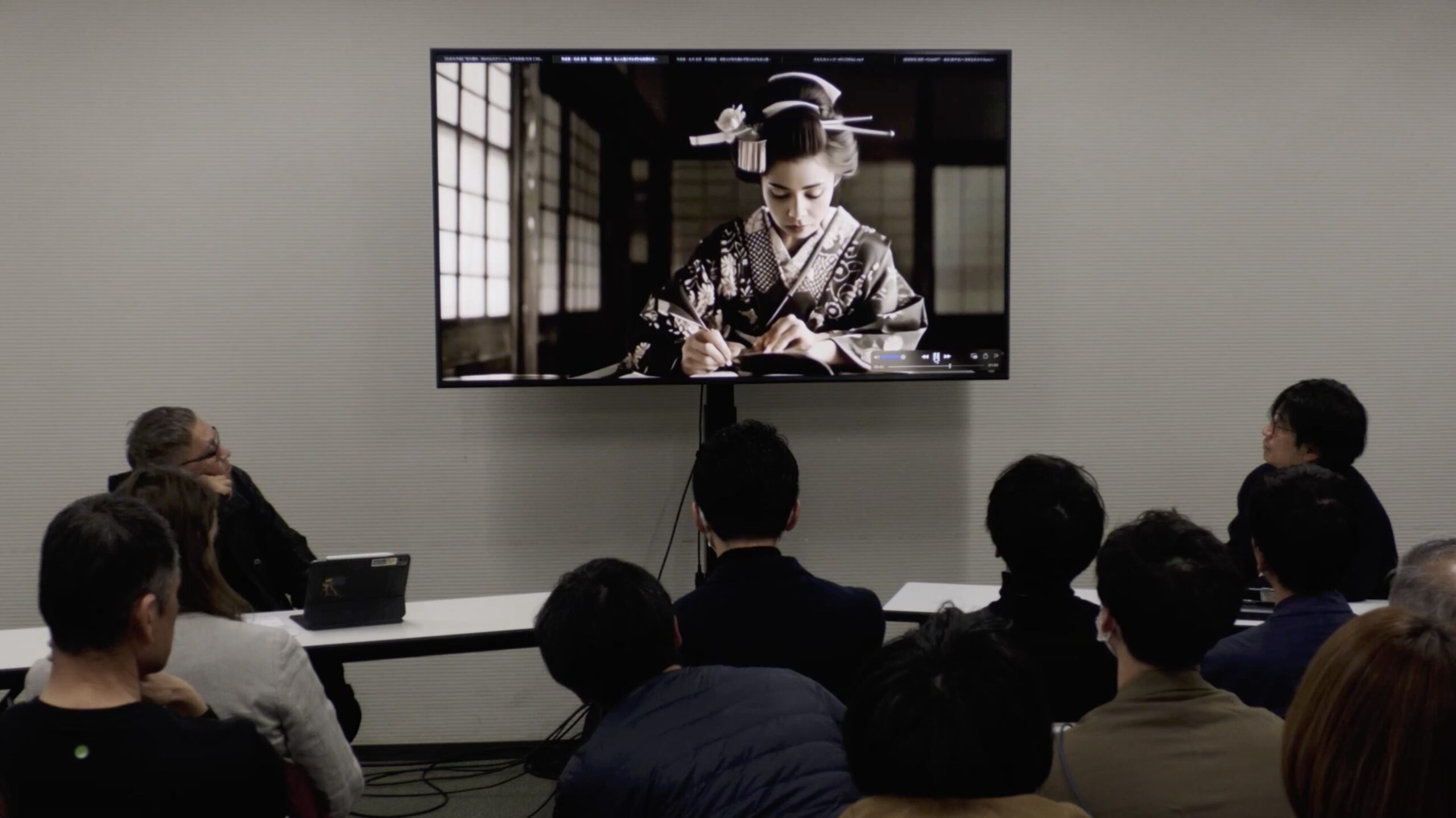
AI-Movie.report

AI-Movie.report
「本日はよろしくお願いします」と司会進行であり、本取り組みの事務局長を務める株式会社AI-Acts代表取締役の坂慎弥の挨拶から始まった「AIと共に最高の映画を創る会」のキックオフイベント。
「AIと共に最高の映画を創る会」はAIを「スタッフの一員」として「自分にとって最高の映画」を創ることを目的にしている。
会を立ち上げた映画監督、三池崇史は「自分が監督するために集まってもらったのではありません。みんなの創りたいものを創りたい表現で実現できるように後押しをし、あわよくば仕事につながればと思っています。」とこの会を発足させた理由を語ってくれた。
AI技術、特に昨今の「生成AI」ブームというのは映画業界においてもその対応に追われている事柄である。例えばハリウッド映画に出演している俳優たちは自分たちの肖像権などの権利に関することを生成AIの普及に伴う課題として声を挙げている。三池監督も「プロの現場において、こうした権利や法律の問題は解決しなくてはいけない」という認識を持っている一方で「『小学生が自分のおばあちゃんのために生成AIを用いて映画を創る』というような可能性の芽を摘むようなことを、自分たちの仕事のために行ってよものか」という葛藤も抱いている。
「職人と普通の人が互いに高め合えるようにしていきたい」と会発足の想いを三池監督は語った。
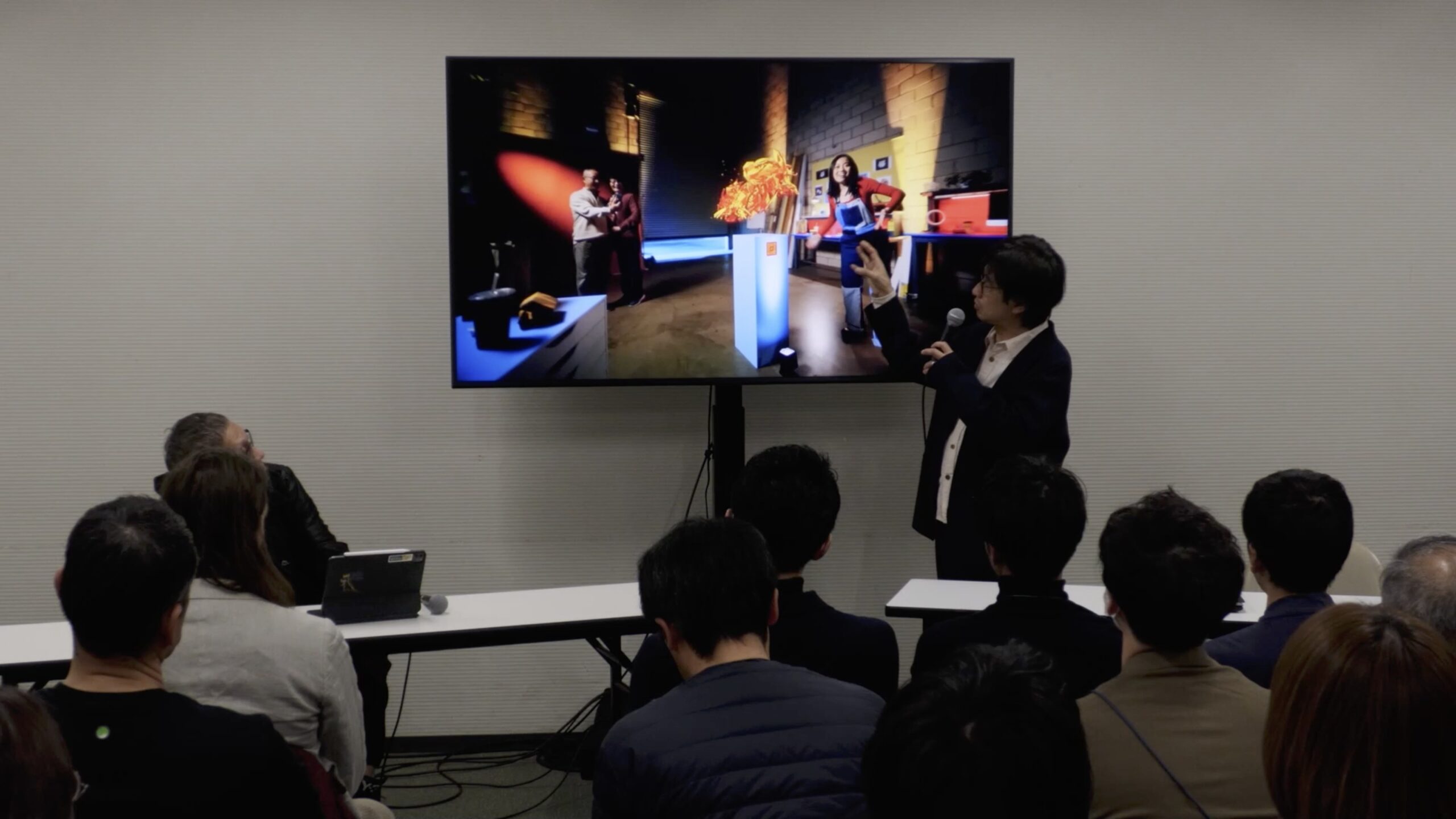
キックオフイベントのもう一人の登壇者であるデジタルコンテンツプロデューサーの小畑正義さんはどのように現場で生成AIを使っているのかを教えてくれた。
当時の生成AIはまだ精度が低く、人間の顔の画像を生成すると二度と同じ顔にならないという課題があった。そこで最初はCGで人間の頭や腕などのパーツをつくり、様々なバリエーションをAIに教えるところから始まった。繰り返し行うことでAIは学習し、10枚中8枚は同じ顔にすることができるようになった。今度はデザインのサイクルが早いアパレル分野で使うことを念頭に、服のバリエーションも覚えさせていく。最初はのっぺりとした陰影のない画像で覚えさせ、次にシワによる歪みや凹凸の陰影を覚えさせていき、質感や重量も伝わるような素材感や被写体が際立つような雰囲気のある背景、照明などが生成されるようになった。
「これまで洋服のデザインなどやったことがなかった私でも何行かのプロンプトでいくつものバリエーションが作れるようになった」と話していたが、数週間前にOpenAI社から動画に特化した生成AI「Sora」が発表され、「これまでの2年間は何だったのか」と笑っていた。
OpenAI社から発表された「Sora」は実際に撮影したかのような非常にリアルな動画を生成することができる。そのようなサービスが発表され、今後2、3年で生成AIはどのような進化を遂げていくのだろうか。
小畑さんは更に生成AIは進化すると語った。一般の方も自由に使うことができるようになり、様々な人が様々なことを生成AIに行わせている。同じことを繰り返し行わせるより、異なることを行わせるほうがAIは学習しやすい。使われ方が多様になり、AIの進化はますます進むと話した。
一方で、大量に情報を処理するためにプロセッサーなどのインフラの影響で進化したAIの普及は鈍化する可能性があることを話していた。
例えば映像や画像などを生成するために必要なGPUというプロセッサーは2社しか製造していない。この2社がどれだけサーバー会社に提供できるのかという課題がある。
さらにインフラだけではなく、インフラを動かす膨大な電力も必要になる。以前、ビットコインのマイニングでサーバーの電力の問題が噂された事があった。AIが普及していくとマイニングにかかる何十倍ものプロセッサーを使用することになり、それに伴い多くの電力も必要となる。クリエイティブやエンジニアリングとは異なる軸での話にはなるが、それもまたAIの普及に影響する。
こうした課題も話した上で小畑さんは「それでもこれまで見てきた映像の進歩の10倍、20倍の速さで進化している」と話してくれた。
それを受け、三池監督はインフラが整えばAIの「推論」能力が高まり、ユーザーの意図まで理解した上で生成を行い、さらに今まで専門家でなければできなかったコミュニケーションも簡単に行えるようになり、誰にでも使えるようになってくると期待している。
実は既にプロンプトを必要としない生成AIも存在する。項目を選べばそれだけで非常にリアルなシーンが自動で生成される。将来、単語しか喋れない幼児でも人形遊びの世界観を映画として創ることもできると小畑さんは語った。
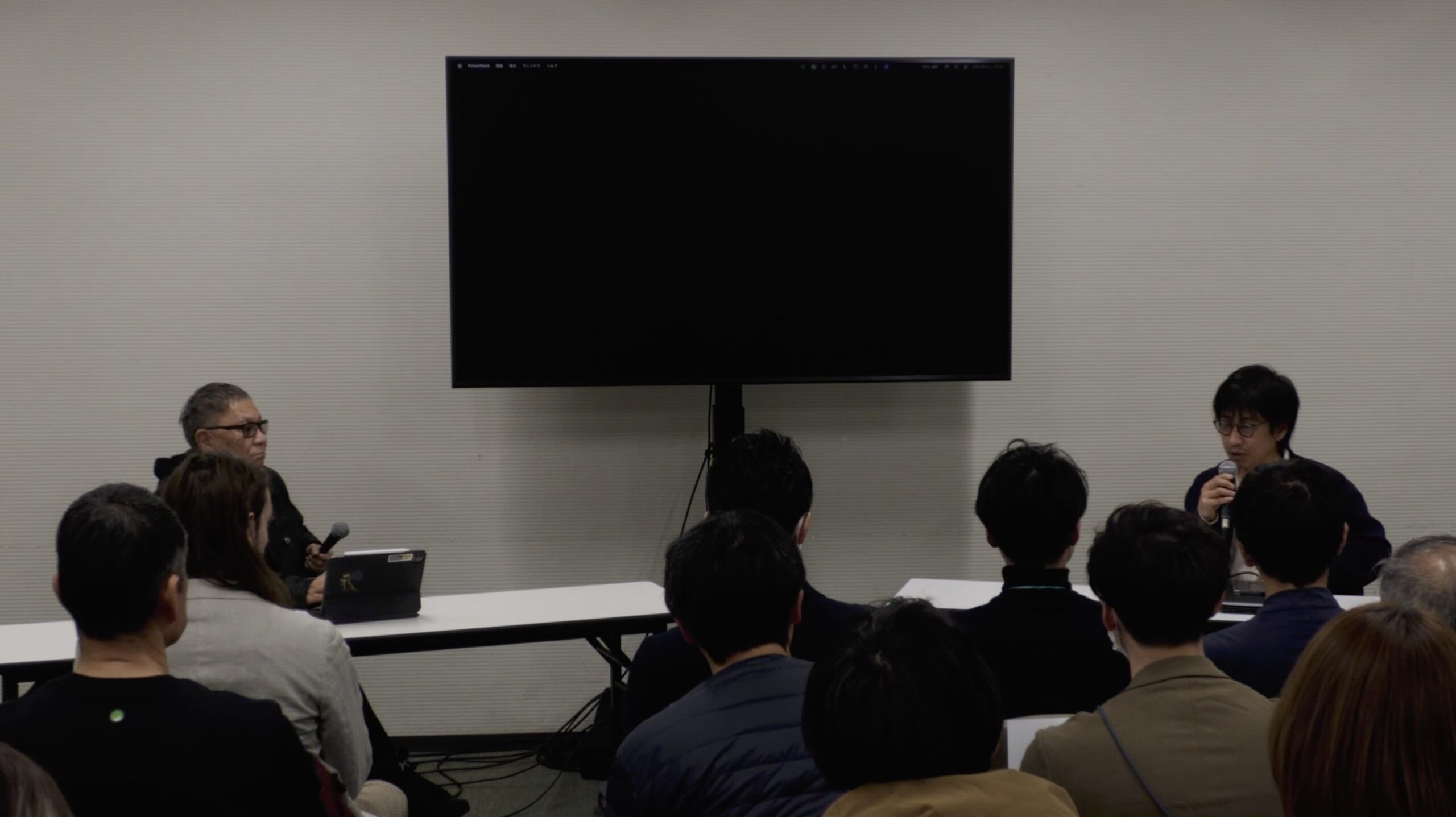
生成AIの普及に伴い、多くの人が簡単に映画を作れるようになった将来、三池監督は「寝たきりでも映画が創れる」と期待を寄せる一方で、「そういったものに果たして価値や魅力はあるのか」という疑問も抱えていた。
その疑問について小畑さんは「『食べるための作品づくり』にAIを用いることで、『創りたいものの作品づくり』にパワーが割ける。プロはスタジオや有名な俳優を使いやすい。コミュニケーションの中でAIを使っていけばクオリティが担保されたものがこれからもできるかも知れない」と語っていた。プロは印象に結びつく表現手法や撮影スタジオ、俳優の所属する芸能事務所などのつながりが多くある。 一般の人でも「観客」という立ち位置でしか作品が見られなかったが、今後は「つくり手」としての視点で作品を見ることができるようになるかも知れない。AIによるアドバイスも合わさりプロとアマチュアの垣根は低くなるかも知れないが、優位性はまだプロの方が高い。
その垣根がなくなり、プロとアマチュアの定義が曖昧になったときに三池監督は「すごい世界観の作品が今後出てくるかも知れない」と期待を寄せていた。

1点目は「としまるさん」の作品だ。ホラー映画の予告編のような作品で、ある通知がスマホに届くと7日後に亡くなってしまうというストーリー。本編では色調や各種エフェクト効果などを巧みに織り交ぜられており、BGMやSEも相まって雰囲気がでている。AIによって生成された人物や背景はボケ感やカメラワーク、照明効果によって立体的に映し出され、立体的な世界が感じられた。
この作品を鑑賞したあと、三池監督は「CGなどが得意としているのは『破壊』のシーン」であると話し、「AIで生成されたキャクターに恐怖を感じたのも関係があるのかもしれない」と自身が感じた上ので考察を語った。
としまるさんは三池監督の作品「着信アリ」から着想を得て本作品を制作している。「着信アリ」は一昔前の折りたたみ型の携帯電話から鳴る着信音が有名になったが、スマートフォンが主流になった現代では、どのような物語ができるのだろうかと考え、本作品が出来上がった。
構想自体はとしまるさんの発案だが、脚本はchatGPTで起こし、素材を画像生成AI、動画生成AI、音楽生成AIによって生成し、編集を行った。制作時間は40分ほど。会場からも「すげーな」と声が上がった。
三池監督は「40分でできたと。我々が2、3かけて撮って、CGに2、3ヶ月かかって、音つけるのに1ヶ月かかって、宣伝半年やって、公開してが40分?すごい!」と会場の笑いを誘いながら驚いていた。

2点目と3点目は同じ白井さんの作品になる。最初に鑑賞した作品のタイトルは「侍たちのひととき」。まるで江戸時代後期から明治時代に取られたセピア色やモノクロの写真かのような世界観の作品。ただこれは静止画のスライドショーではなく、人物はゆっくり動き、カメラワークもついている動画である。作中、女性の髪飾りにフォーカスがあたる場面があるが、陰影が自然で細部も潰れていたりはしていなかった。晴れた日と雨の日の着物の重量感の違いや風で動く木々も自然であった。また、日本人特有の顔立ちも表現されていた。
次に鑑賞したものは「誇り高き消防士」である。海外の火災現場で活躍する消防士を題材にした作品だ。炎の噴出やゆらぎは自然で、放水による地面の水たまりの光の反射も非常にリアルだ。面白いことにまるで本当にカメラを用いて撮影したかのようにレンズに付いた水滴まで表現されていた。
小畑さんは「CGで再現しようと思うと何ヶ月もかかってしまう。それだったら実際に撮影したほうがいいのではと思うかもしれないが、これだけ多くの消防車を用意するだけで多くの費用がかかってしまう」と今までの撮影手法について話した。続けて「このクオリティで自分の考えを表現できるというのはアマチュアの人がぐっと上に引き上げられ、アマチュアとプロとの差が狭まってくる」と現在から将来にかけての映画制作についての考えを話した。
白井さんは「侍がすごく大変だった。日本人の顔は生成AIだときれいに表現しにくい。なので元になる画像をつくるのに丸1日くらいかかった。」と作品づくりの苦労し点を話ながら制作期間を教えてくれた。それでも映像制作に要する時間としては相当短い。
「生成AIだと「京都」というワードで日本の世界観が出やすかった。なので「京都」というワードだけは変えずに他のワード、例えば「月」や「橋」といったものに情景をつけながらプロンプトを入れ替えて生成していった」と作品作りのプロセスを白井さんは教えてくれた。それを聞き、三池監督は「同じ俳優が演技する長い作品づくりというのは今の時点では大変だということ。でもそうした特徴を生かした生成AIでつくった映画というものが生まれてくるかもしれない。」と自身の考えを話しくてくれた。

4本目の作品は「AIシンガーMV」というタイトルで応募されたそねちさんの作品だ。作品の内容はキャラクターが歌う曲に映像を付けたミュージックビデオだ。作品中に登場するオブジェクトの陰影と質量感はとてもリアルで、登場するキャラクターもとても自然だ。筆者は遠目から作品を鑑賞したが、現在のCGやセットを活用して撮影された作品との違いがわからないくらい、違和感が感じられなかった。
当日そねちさんは会場には来られていなかったが、小畑さんは「リップシンクは最初につくった人物の顔にディープフェイクという人物の顔をすげ替える生成AIツールでつくったのではないか」と技術的な推論を話してくれた。
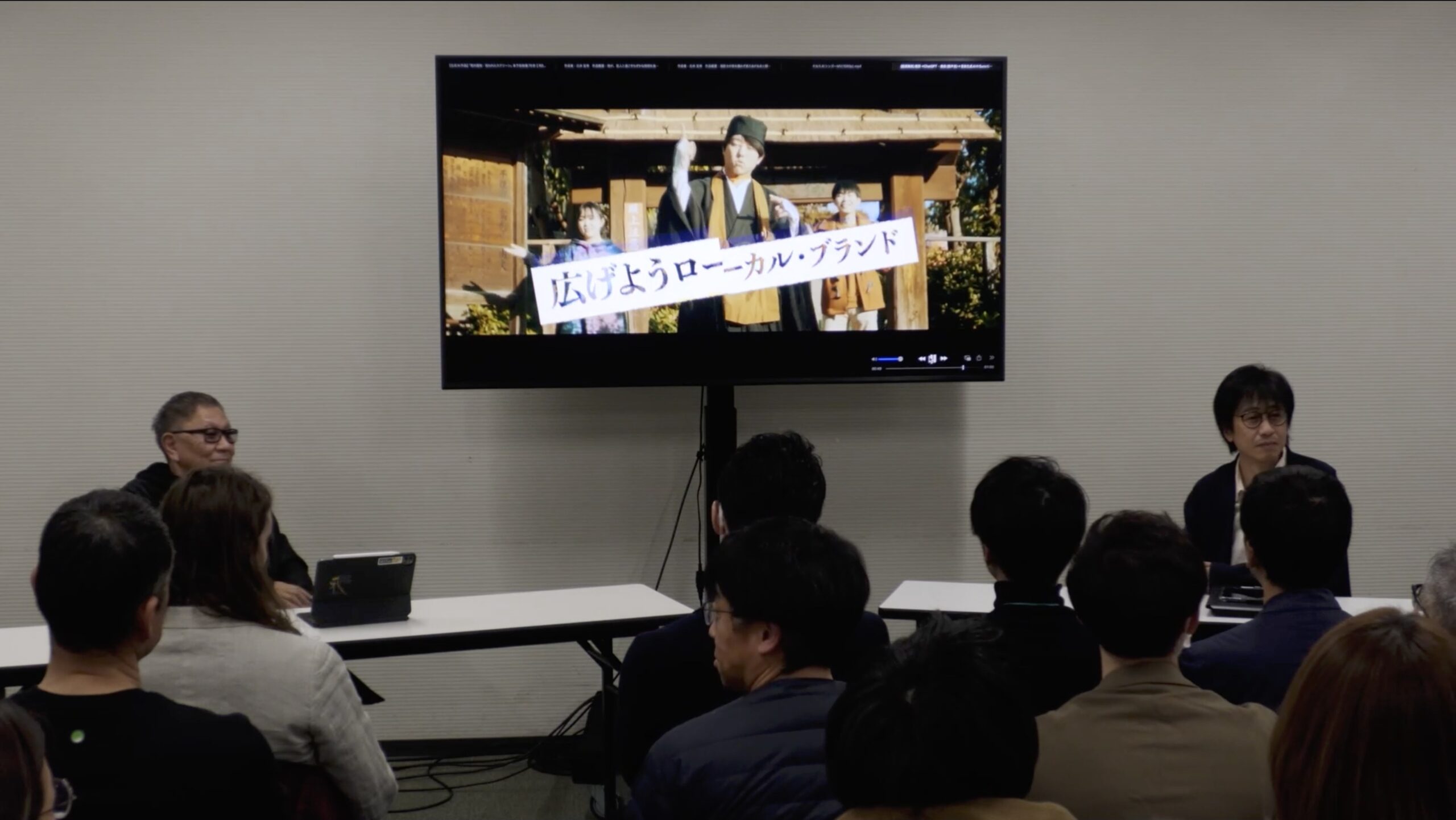
5本目は服部さんによる「東京都足立区PV」という他とは異なる作品である。生成AIが担当したのは曲と歌詞、声の部分。映像は実際に撮影したものが中心。
三池監督は「一緒に作品を作る仲間としてAIはどうでしたか?」と聞くと「最近はドラマ台本の制作にも挑戦している途中で、いかに本物らしい表現でドラマをつくっていくのか、探っている最中で、とても楽しい」と服部さんは答えてくれた。服部さんは映像制作に携わる方で、リテラシーを上げたいという想いで、色々と挑戦している。
三池監督は「服部さんのつながりでたまたま足立区だったが、他の自治体でもつくることができる。今回の作品のようなものを一手に請け負うこともできるかもね」と今回の作品から他のバリエーションを「ゆるキャラ」を例に挙げながら話した。
また、三池監督は「映画は構想を考える時点からお客さんに診てもらうまで3年くらいかかる。AIでつくった映画なら今の旬なものをつくることができる」とAIと共につくる映画への可能性について話した。
質疑応答の時間では、会場にいたの男性は「僕にとっての最高の映画とは「面白いもの」であり、どんなにCGがすごくても話が面白くなければ単なる映像作品。きっとこれからの映画制作ではライティングやカット、進行のテンポやストーリーなどの部分で人の手が入るのではないか」とご自身の映画に対する想いを語った。そのうえで、「人が面白いと感じるストーリーやテンポなど、感情に直接影響する部分でさえもAIに取って代わられてしまうのだろうか」と質問をした。
この質問に対し、三池監督は「基本的にはものすごく映画に詳しい映画オタクで刺激を与えてくれる人と一緒。(映画作りに携わる人は)鵜呑みにせず、我のようなものも必要だと思う。AIは良きパートナー」と笑顔で答えてくれた。
また、別の方は「僕たち高校生が、AIによってなんでもつくれるようになった社会で、どんなことを学んでいけばよいだろうか」と質問をした。
三池監督は「まずは楽しむこと。楽しいことがあれば自然と学びたくなる。映画が好きであれば自然とつくりたくなる」とここでも冗談を交えながら答えた。
三池監督はイベントの最後に「今回AIと共に最高の映画を創るにあたって、様々なプロジェクトごとにそれぞれの役割や動き方を当てはめるように考えている。時間という問題もあるかもしれないが、まずは創ってみて、出してみて、先を切り開いていく。これから僕らが思ってもいなかったことが起きてくると思っています。共にその変化を楽しんでいけたらと思います」と挨拶を行った。
昨日できなかったことが今日できるようになってしまうくらい、AIに関する技術の進歩は早い。三池監督が言うようにAIが人の感情を理解する日もそう遠くない将来来るかもしれない。それでもあなたの映画はあなたが監督であり、AIはそれを支える良きパートナーである。同じ映画を共に考え、あなたにとっての最高の映画を楽しみながら創ってもらえたらと思う。
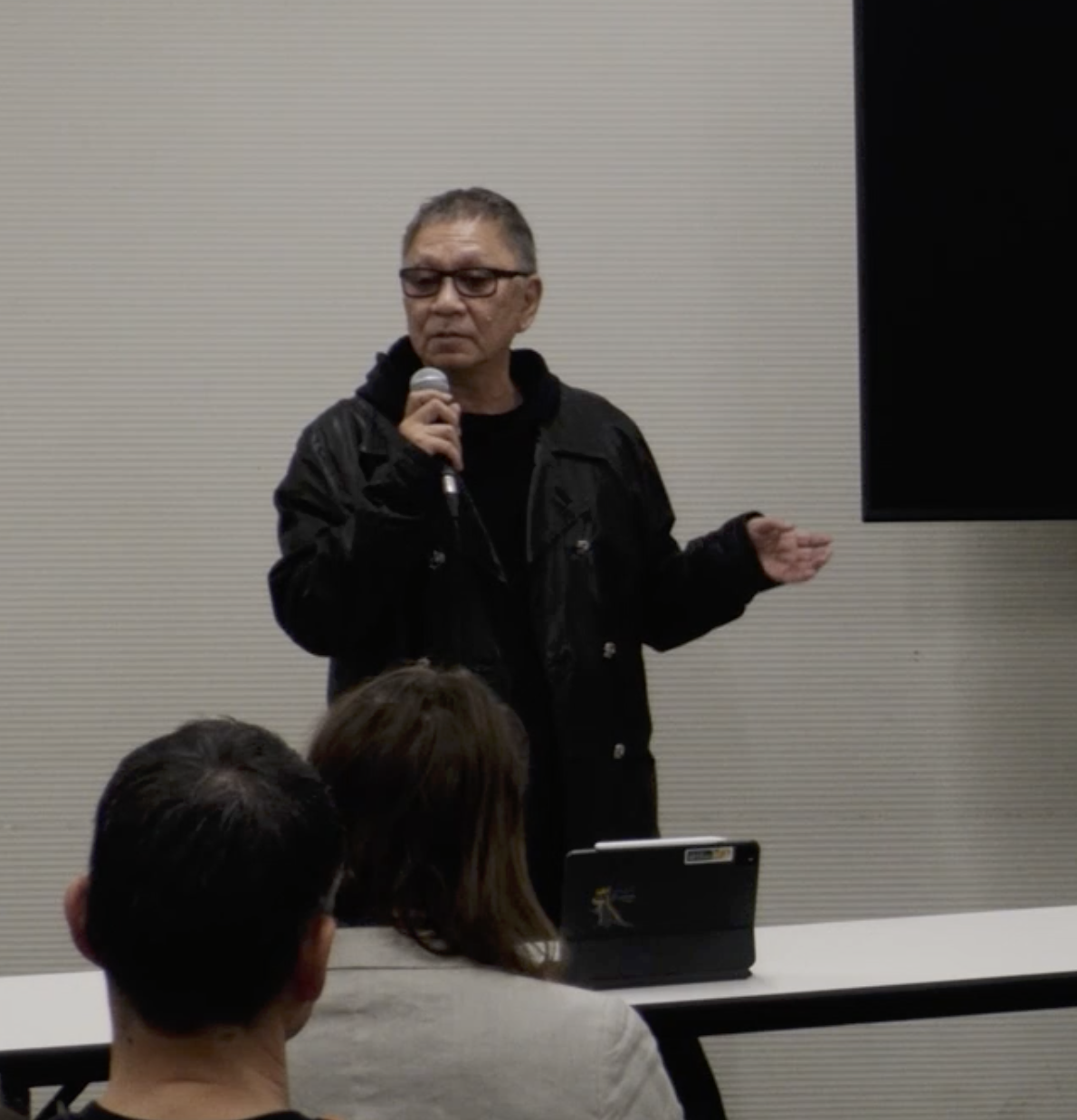
映画監督
1960年生まれ・大阪府出身の映画監督であり、今までの撮影本数は130本を超す。
国内でヒット作を多数輩出する一方、海外からも評価が高く、カンヌ国際映画祭には『一命』と『藁の楯 わらのたて』が、
ヴェネチア国際映画祭には『十三人の刺客』が選出された。
米国アカデミー会員でもあり、代表作に「オーディション」「DEAD OR ALIVE」「着信アリ」「クローズZERO」「土竜の唄」などがある。
また近年、配信サイトNetFlixではアニメーション作品『鬼武者』や、Disny+では韓国との共同制作『コネクト』なども手がけている。

デジタルコンテンツプロデューサー
CG聡明期からNHKエンタープライズにて、大河ドラマなどのCG制作を担当。
初期の三池作品のVFXディレクターを長年務め、早稲田大学教授などの教員職も歴任。
現在は、生成AIやXRを取り入れ、エンタメ分野から産業分野まで3Dデジタルデータの企画制作を進めている。
The kickoff event for “Creating the Best Movies with AI” began with a greeting from Shin’ya Saka, the Director General of the initiative and Representative Director of AI-Acts Inc., saying, “Thank you for being here today.” This initiative aims to use AI as “a member of the staff” to create “the best movie for oneself.”
The founder, director Takashi Miike, explained the reason for launching this group: “I did not gather everyone here just so they could work under my direction. Instead, I want to support the realization of what everyone wants to create, in the way they want to create it, and hopefully, it could lead to job opportunities.”
AI technology, especially the recent “generative AI” boom, poses challenges that the film industry must keep up with. For example, actors in Hollywood films have raised concerns about their rights, such as image rights, as challenges arising with the proliferation of generative AI. While acknowledging the need to resolve these rights and legal issues in professional settings, Director Miike also expressed a conflict, stating, “Should we, for our own work’s sake, stifle the budding potential, like an elementary school student creating a film for their grandmother using generative AI?”
Director Miike shared his vision for the initiative: “I want to create an environment where craftsmen and ordinary people can elevate each other.”

At the kickoff event, digital content producer Masayoshi Obata shared how generative AI is being used in the field. Initially, generative AI had low accuracy, and when generating human faces, it couldn’t produce the same face twice. The approach began by creating human body parts like heads and arms in CG, teaching these variations to the AI. Through repeated processes, the AI learned to replicate the same face in 8 out of 10 attempts.
Obata then focused on applying this technology in the fast-paced fashion industry, teaching the AI to remember various clothing styles. Initially, the AI was taught with flat, shadowless images, progressing to learning the nuances of wrinkles, shadows, and textures. This progression allowed the creation of images that not only conveyed texture and weight but also featured atmospherically rich backgrounds and lighting.
Obata remarked, “Even I, who had never done anything like designing clothes, was able to create multiple variations with just a few prompts.” He laughed about the recent launch of ‘Sora,’ a video-specific generative AI by OpenAI, joking, “What were those two years all about?” This highlighted the rapid advancements in AI capabilities and their transformative impact on creative fields.
OpenAI’s “Sora” can generate highly realistic videos that appear as if they were actually filmed. With such services being launched, one wonders how generative AI will evolve in the next two to three years. Mr. Obata mentioned that generative AI will continue to evolve, becoming freely usable by the general public, and a variety of people will have it perform a variety of tasks. It learns easier when tasked with diverse activities rather than repetitive ones. As its applications diversify, AI’s evolution will accelerate.
However, he also discussed the possibility that the spread of advanced AI could be slowed by infrastructure limitations such as processors needed to handle large amounts of data. For example, only two companies manufacture the GPUs necessary for generating images and videos. There are challenges related to how much these two companies can supply to server companies.
Moreover, not just the infrastructure, but the vast amount of electricity required to power it is also a concern. There was a time when the power consumption of servers for Bitcoin mining was rumored to be problematic. As AI becomes more widespread, it will use many times more processors than mining, requiring a correspondingly large amount of electricity. While this is a different discussion from creativity or engineering, it also impacts the spread of AI.
Despite these challenges, Mr. Obata stated that “the pace of progress is 10 to 20 times faster than any video advancements we’ve seen before.”
In response, Director Miike anticipates that as the infrastructure improves, AI’s “inference” capabilities will increase, enabling it to understand and generate based on user intentions, and even simplify communications that previously only experts could manage, making it accessible to everyone.
In fact, generative AI that does not require prompts already exists. Selecting options alone can automatically generate highly realistic scenes. Mr. Obata suggested that in the future, even toddlers who can only speak a few words could create a cinematic world of their doll play.

With the widespread adoption of generative AI, many people will be able to easily make movies in the future. Director Miike hopes that “even someone bedridden could create films,” yet he also harbors doubts about whether such creations will indeed possess value or appeal.
Mr. Obata addressed this concern, stating, “Using AI for ‘production for the sake of eating’ frees up energy for ‘creating what one truly wants to create.’ Professionals have easier access to studios and famous actors. If communication incorporates AI, it may continue to ensure quality productions.” Professionals have numerous connections to expressive techniques, shooting studios, and talent agencies. While the general public used to view films only as ‘audiences,’ they might soon be able to see them from a ‘creator’s’ perspective. Advice from AI might lower the barriers between professionals and amateurs, though professionals still hold an advantage.
When the barriers disappear and the definitions of professionals and amateurs blur, Director Miike anticipates that “we may see amazing works with incredible worldviews emerge.”

The first piece is by “Toshimaru-san.” It resembles a horror movie trailer, featuring a story where receiving a certain notification on a smartphone leads to death seven days later. The main feature skillfully incorporates various color tones and effects, and the atmosphere is enhanced by the background music and sound effects. Characters and backgrounds generated by AI appear three-dimensional through effects like blurring, camera work, and lighting.
After viewing this work, Director Miike commented that “scenes of destruction” are something CG excels at, and mentioned, “The fear induced by the AI-generated characters may also be related.” Toshimaru-san was inspired by Miike’s film “One Missed Call” for this work. “One Missed Call” was known for its ringtone from an old flip phone. Toshimaru-san wondered what kind of story could be created in today’s era of smartphones, leading to the production of this work.
The concept was Toshimaru-san’s idea, but the script was drafted using ChatGPT, and the materials were generated by image, video, and music AI, followed by editing. The production took about 40 minutes, and the audience was impressed, expressing admiration.
Director Miike joked about the rapid production, “It took 40 minutes? We spend 2-3 days shooting, 2-3 months on CG, a month on sound, half a year on promotion, and then release—all in 40 minutes? Amazing!” while eliciting laughter from the audience.

The second and third pieces are both works by Mr. Shirai. The first piece viewed was titled “A Moment of Samurai,” reminiscent of a sepia or monochrome photograph taken from the late Edo to the Meiji period. However, this was not a static slideshow of images; the characters moved slowly, and the video included dynamic camera work. One scene focused on a woman’s hair ornament, where the shading was natural, and the details were not crushed. The difference in the weight of the kimono on sunny days compared to rainy days and the natural movement of trees in the wind were also effectively depicted. The distinct facial features of Japanese people were accurately represented.
The next piece viewed was “The Proud Firefighter,” featuring a firefighter at work at an overseas fire scene. The flames’ eruption and fluctuation were natural, and the reflection of light on puddles formed by firefighting efforts was incredibly realistic. Interestingly, even water droplets on the lens, as if actually filmed with a camera, were depicted.
Mr. Obata commented on the traditional filming methods, saying, “It would take months to recreate this with CG. One might think it’s better to film it in reality, but just preparing many fire trucks would be very costly.” He continued, “Being able to express one’s thoughts with this quality narrows the gap between amateurs and professionals, elevating amateur filmmakers.”
Mr. Shirai shared the challenges of creating the piece, “Samurai was very tough. It’s difficult to cleanly represent Japanese faces with generative AI, so it took about a whole day just to create the base images.” Yet, even with these challenges, the production time was considerably short.
“Using generative AI, the word ‘Kyoto’ easily brought about a Japanese ambiance, so I kept the word ‘Kyoto’ unchanged and changed other words, like ‘moon’ or ‘bridge,’ while adding scenery to the prompts,” explained Mr. Shirai about his creative process. Hearing this, Director Miike commented, “It’s currently challenging to create long works featuring the same actor performing, but movies made with generative AI that utilize these characteristics might emerge.”

The fourth entry is a work by Sonechi titled “AI Singer MV.” The content is a music video featuring a character singing a song with accompanying visuals. The shading and mass of the objects appearing in the work are very realistic, and the characters also appear very natural. From a distance, I watched the work and could not discern any difference from current works shot using CG or physical sets; there was no sense of discomfort.
Sonechi was not present at the venue on the day, but Mr. Obata speculated, “The lip sync might have been created using a generative AI tool called deepfake, which swaps the faces of the characters initially created.”

The fifth entry is a unique work titled “Adachi Ward, Tokyo PV” by Hattori-san. Generative AI was responsible for the music, lyrics, and vocals, while the visuals primarily consisted of actual footage.
Director Miike asked, “How was it working with AI as a collaborator on the project?” To which Hattori-san replied, “I’m currently experimenting with scriptwriting for dramas, exploring how to create authentic expressions in drama, and it’s very enjoyable.” Hattori-san is involved in video production and is eager to enhance his literacy by taking on various challenges.
Director Miike noted, “It happened to be Adachi Ward through Hattori-san’s connections, but it’s possible to create similar projects in other municipalities. We might be able to undertake projects like this one entirely,” while discussing other possible variations, using “Yuru-chara” (mascots) as an example.
Furthermore, Director Miike discussed the potential of filmmaking with AI, stating, “It takes about three years from conceptualizing a movie to showing it to the audience. With AI-made films, it’s possible to create something that’s currently trendy.”
During the Q&A session, a man in the audience shared his views on what makes the best movie for him: “For me, the best film is ‘something interesting,’ and no matter how impressive the CG, if the story isn’t interesting, it’s just a visual piece. I believe that human touch will still be necessary in aspects like lighting, cuts, pacing, and storytelling in future film production.” He then asked, “Could even the parts that directly affect our emotions, like what we find to be an interesting story or pacing, be replaced by AI?”
Director Miike responded, “Essentially, I think it’s like having a really knowledgeable film buff who stimulates you. Those involved in filmmaking shouldn’t take things at face value, and need to have their own input. I see AI as a good partner,” he answered with a smile.
Another person asked, “As high school students in a society where AI enables us to create anything, what should we learn?”
Director Miike advised, “First, enjoy. If there’s enjoyment, you’ll naturally want to learn. If you love movies, you’ll naturally want to make them,” again answering with humor.
At the end of the event, Director Miike said, “In creating the best movies with AI, we are thinking about fitting each role and action to various projects. There might be issues with time, but first, let’s create, let’s release, and let’s pave the way forward. I believe things we haven’t even thought of will start happening. I hope we can enjoy these changes together.”
The advancement of technology related to AI is rapid; what couldn’t be done yesterday might become possible today. As Director Miike mentioned, the day when AI understands human emotions may not be far off. Yet, your film remains your own direction, and AI is there to support you as a valuable partner. I hope you can think about the film together and enjoy creating the best movie for you.

Film director
Born in 1960 in Osaka Prefecture, this film director has directed over 130 films to date.
He has produced numerous hits domestically, while also receiving high acclaim internationally.
His films “Ichimei” and “Wara no Tate” were selected for the Cannes International Film Festival, and “13 Assassins” was chosen for the Venice International Film Festival. He is also a member of the Academy of Motion Picture Arts and Sciences in the United States.
His notable works include “Audition,” “DEAD OR ALIVE,” “One Missed Call,” “Crows ZERO,” and “Mogura no Uta.”
Recently, he has also worked on animation projects like “Onimusha” on Netflix and a co-production with Korea called “Connect” on Disney+.

Digital content producer
From the early days of CG, he worked at NHK Enterprises, handling CG production for historical dramas and other projects. He served as the VFX director for early works by Miike for many years and has also held teaching positions, including as a professor at Waseda University. Currently, he incorporates generative AI and XR, advancing the planning and production of 3D digital data across entertainment and industrial sectors.